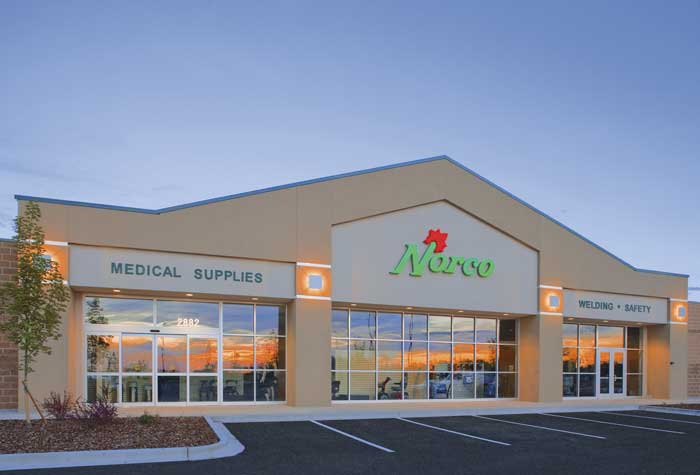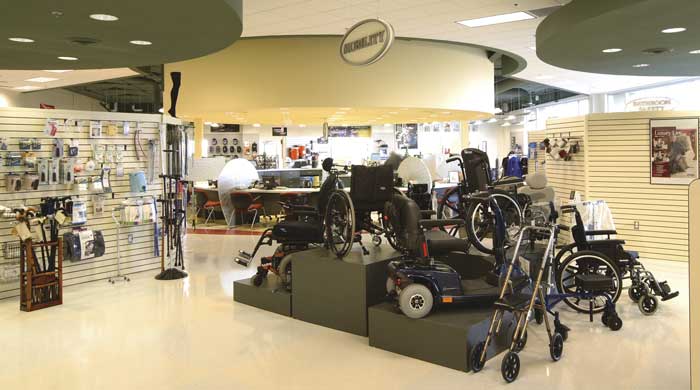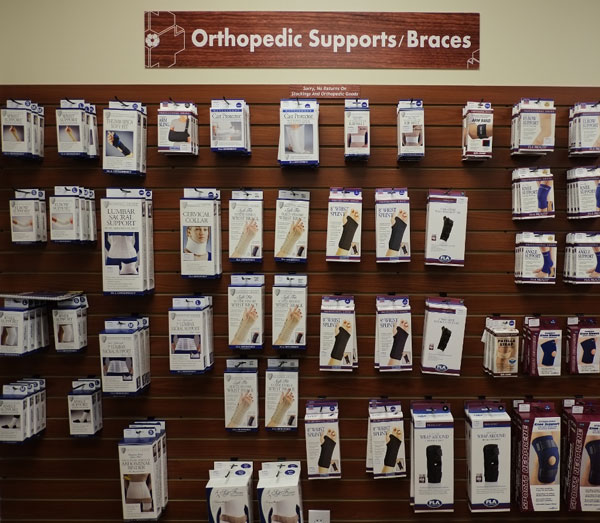Everyone appears to have a different concept of what retail means in home health care. I receive calls weekly from HME businesses that believe they can simply expand into retail by adding a showroom to their reimbursement-driven, warehouse-based operation. Wrong.
The following is a self-help guideline to follow when developing a retail HME business. Or you can simply use this list as a reference guide of “Retail HME Best Practices” to see how you compare and what you need to do to improve.
Concept/Niche
You have probably heard the old adage, “Throw everything up against the wall and see what sticks.” Unfortunately, we can no longer afford to operate this way in retail HME because the high overhead for product and staff can sink the operation. If a retail business is to be profitable, there must be a return on investment. That means the majority of product categories in any given store need to generate profit. Sales volume is not nearly as important as gross profit margin.
Retail businesses today differentiate themselves in numerous ways. Most often, their product or service offering is unique. This uniqueness is the niche they fill, as well as their core profit center, name and/or tagline and the theme of their business. In retail HME this translates into businesses that focus on:
- home accessibility/aging in place
- sleep apnea
- mobility
- independence at home
- diabetic shoes and compression
- women’s health
Name/Logo/Tagline
When you think of Toys R Us, you think of toys. This is a perfect example of a “category killer” and ultimate destination business in their respective category. In our channel, retail HME businesses also need to announce their specialty/niche in their name and tagline (the short four to six words that are usually shown in italics under a business’s name and logo).
When naming a retail HME business, remember that you want to let consumers know you are selling products. Too often, consumers assume that home care means nursing services. Try to use unambiguous words in your name, such as “store,” “products” or “equipment,” as in Medical Equipment, Medical Supply, Medical Products, Homecare Products, Homecare Store, Home Medical Store, Home Medical Products, etc.
The logo is a graphic representation of your name. You can easily contact a graphic design department at a local college to find an affordable graphic artist or simply go online to search for one. Remember to create a logo that is legible, highly visible and easily recognizable.
The tagline complements a business name and highlights your intangible offering. Too often, businesses in retail focus on quality in relation to products or service. But in retail HME, our focus is on caring in addition to providing superior customer service. Example taglines I have seen include:
- We Care About Your Health
- We Serve and Care for Our Community
- We Treat You Like Family!
Demographics
The first question I am always asked regarding demographics is whether a retail HME will work in rural areas or only in urban cities. Retail HMEs need a sales territory that includes approximately 150,000 people. This refers to both the immediate retail zone within a three to five mile radius, plus the surrounding cities, towns and counties that are within the overall sales area. I have launched retail HMEs in rural towns of 3,000 that are very successful.
What demographics are ideal for retail HME businesses? There are no guarantees, but here are a few specifics to look for:
- Minimum 12-15 percent seniors (12 percent is the national average)
- 15-plus years old is largest group of minors (= older families = Baby Boomers = family caregivers)
- Minimum 55 percent home ownership (majority of residents as homeowners = aging in place)
- Minimum household income = $60,000

Retail Location
The issue with traditional HME businesses is that they are located in light industrial or commercial zones. In retail, this translates into single destinations that constitute a special trip and are difficult to find. In contrast, retail businesses are easily visible and accessible, plus they are usually located near other related businesses that attract the same customers.
There are actually two different retail scenarios for HME businesses. The first, which is more traditional, is to locate within a medical community: medical office building, hospital lobby or campus or medical mall. The other is pure retail: strip center, shopping center or busy retail thoroughfare. One benefit of the recession is that retail space rents have decreased, and most strip malls only charge $1.60-$1.80 per square foot per month now.
Retail Days and Hours
The open hours at retail HME businesses are dependent upon their respective locations. Medical locations keep doctors’ hours: Monday through Friday, 9 a.m. to 5 p.m. However, retail locations are usually open later and on Saturdays in order to cater to their customers.
Given that 65 percent of retail HME customers today are middle-aged women, retail HMEs must be open when female Baby Boomers/adult children/family caregivers are available to shop. This means until 6 p.m. daily (on their way home from work) and at least four hours on Saturdays. Saturdays are usually the highest grossing day of the week, and usually average 80 to 90 percent cash sales.

Retail Showroom
The average retail HME business occupies 1,800-2,400 square feet of space. This includes 1,000-1,500 square feet for the showroom, a CSR’s desk with the cash register located in the front third of the showroom, possibly a fitting room and 300-400 square feet as a combination storeroom and lunchroom. Larger spaces will also include the manager’s office in back with a one-way window to the showroom.
Display space is critical for the success of a retail HME showroom. Products must be taken out of the box and off the shelf if they are going to sell. The majority of space is dedicated to displaying products on the floor that customers can touch, try and then buy. The front windows are also used to display the larger core products on risers.
Showroom Sales
The key to successful sales, turns and profits is matching the HME product categories with the area’s customer demographics. The front third of a retail store generates 80 percent of their sales. In the HME market, if local customers are seniors, then mobility, bath safety and patient room products are displayed up front. If Baby Boomers are the primary local customers, then diagnostics, diabetic shoes, compression stockings and orthopedic supports are displayed up front.
The other interesting phenomenon in retail HME showrooms is that the more you display, the more you will sell.
Here are some benchmarks to consider:
- 800 square feet will generate $400-$600 per square foot in gross sales per year.
- 1,500 square feet will generate $800 per square foot in gross sales per year.
Retail HME Revenue
The profitable full-service retail HME business’s revenue is basically divided into a third each from Medicare/Medicaid, third-party insurance and retail.
A more-precise breakdown is as follows here:
- 20-40 percent Medi/Medi
- 10-35 percent private insurance
- 50-65 percent retail (cash, credit card and check)
This same average retail HME generates $800 per square foot in gross sales per year (note: This is based on a minimum 1,000 square-foot showroom, dedicated retail salespeople and ongoing advertising). The average retail sale is between $160 and $200 per customer (i.e. most customers buy at least two products, the core product and at least one related add-on product). The resulting $1 million in gross sales generates 8-12 percent net/net, with 12-15 percent net/net in fully-automated operations.

Complete Product Selection
This is one aspect that sharply contrasts traditional reimbursement-driven HMEs against retail HMEs. In the former, if any product is displayed it is multiples of the basic reimbursable model (i.e. medical necessity product bought in volume). In the latter, multiple options of all core products are displayed (i.e. good/better/best lifestyle products). Mobility products also differentiate easily, because basic medical necessity products are always chrome while upgraded lifestyle products offer more attractive colors and designs.
In retail, stores display good/better/best product options to offer customers choices in price, product features and personal benefits. In our retail HME channel, usually the “good” product is the basic reimbursable model, while the “better” and “best” products are the upgraded options. Given that our primary retail HME customers today are female Baby Boomers, these consumers will make their purchasing decisions in the retail store that offers them product options from which to choose.
Room Set Displays
No one needs only one grab bar! If you simply present a planogram for bath safety, customers will buy only one grab bar or only one elevated toilet seat. But by displaying all of the related bath safety products in and around a tub and commode, HMEs visually educate their customers. They sell a package rather than a single product (i.e. the core product plus one or two related products) by displaying all of the products that someone will need at home to be independent in the bathroom.
The same holds true for the bedroom. Include all related products that someone might need at home in the patient room display: sheets, chucks, memory foam overlay, wedges, cervical pillows, standing-assist products, reachers, bedpan, urinal, skin care, pouches, overbed table and a bedside commode. Possibly expand the patient room into a Sleep Center, including CPAP and respiratory products as well. The goal in these floor displays is to provide end users with a vision of themselves living at home with independence, mobility and dignity.
Window Displays
Retail showroom windows sell 24/7 at no extra cost, but they must be changed if you want consumers to look at them (at least monthly). Window risers 18-24 inches high make products more visible to people driving and walking by. Use two sets of track lighting, one along the top of the window and one 3-4 feet in from the window. This provides backlighting for products and 3D effects so the displayed products “pop” at night and on cloudy days.
Usually larger core products are displayed in the front windows: scooters, power chairs, lift chairs, transport/wheelchairs, rollators, bath chairs and transport benches. Smaller items are best displayed on mannequins: orthopedic supports, compression stockings, hot/cold gel packs and first aid or wound care and scrubs.
Priced to Sell
In retail, all products have visible retail prices displayed on them. But HMEs are usually afraid to post prices due to Medicare’s restrictions on posting (i.e., “substantially in excess of the supplier’s usual charges”). However, Medicare has noted that they are aware that the extra steps in billing Medicare costs more than accepting cash for any given product. Therefore legal expert Jeffrey Baird recommends that Part B HME providers can deduct 17 percent from the Medicare allowable price (i.e., the “usual charges,”) for all cash sales. Most retail HMEs deduct 17-20 percent for cash sales on a regular basis without any legal issues. Part B providers also post signs around their showrooms stating, “Ask us for our retail pricing,” “Ask us for our cash prices” or “Ask us about our sale pricing.” In this way their customers are informed they do offer retail cash prices that are lower than the posted Medicare allowable prices.

Just-in-Time Inventory
Take a lesson from Wal-Mart and replenish just what you sell. Retail HMEs do not need a 1,000 square-foot warehouse stocked to the ceiling, with all of your marketing and advertising monies tied up in old inventory. Use the distributor’s warehouse as your own. Every product has a carrying-cost attached to it, and the longer it sits in your warehouse, the more it costs you.
Retail businesses cannot afford to be out of stock of their most popular sellers. Why? When a customer cannot find the product for which they are searching, they will go elsewhere to shop. If they find—and buy—the product easily at your competitors or online, then the next time they need an HME product, where do you think they will go? So not only do you lose a sale in the short-term but a potential lifetime customer as well.
Retail CSRs
Hire for attitude, not skills! I have found that a new retail HME business will have a higher probability of success—and profitability—if they simply hire retail salespeople and train them on the specifics of HME. Rarely do HME insurance veterans enjoy or succeed at retail sales.
Customer service representatives should view every insurance patient as a retail sales opportunity. Instead of first asking which insurance company covers the patient, they qualify the customer and then follow a solution sales approach to show the customer all of the core and related equipment and products that will improve their quality of daily life at home:
- Who is the end-user?
- What is their medical condition?
- Do they have any special health care needs or lifestyle concerns?
Retail Advertising Best Practices
Most retail businesses need ongoing advertising to generate new customers who can then be converted via superior customer service into loyal, repeat customers. For a retail business to establish their brand and generate sales from new customers, advertising must be frequent enough to saturate a given market. This generally means utilizing print ads two or three times per month plus TV or radio ads two weeks per month for most of the year. The average retail HMEs advertising budget ranges between $800 and $1,200 per month (or 5 percent of gross sales), depending upon their respective monthly sales and the size of their sales territories.
Social Networking
Social networking sites are more proficient and successful with SEO (search engine optimization) than most independent businesses are with their own websites. Often when you search for a specific type of local business, these social networking sites will pop up first offering peer reviews.
Ask your customers if they are satisfied with your customer service and to please review you online. Yelp is of course the largest peer review source, but other websites include Facebook (“Like us!”), Yahoo Local, Google Plus, Foursquare and Weblocal. Offer weekly specials on Facebook and post health information and specials once or twice per week on Twitter.
Annual Open House
Successful retail HMEs are continually hosting open houses in their respective niches to promote their business name (i.e. brand recognition) and professional expertise in home health care. For referral sources, host a wine-and-cheese reception after work during the week. For family caregivers and Baby Boomers, host open houses on Saturdays so they are available to attend.
Invite vendors to display and demonstrate their products. Charge them for tables to defer food costs. Offer free raffle and door prizes (also donated by vendors). Invite a local hospital, medical or insurance executive to present a brief keynote talk. Invite all local media to attend and a local radio station to broadcast live. Usually these events are profiled on the local news that night, and result in more sales than any paid advertising can generate.
Hub-and-Spoke Growth
When existing HMEs expand into retail, they are more cost-effective by not having to duplicate all of their traditional services in every location. They simply keep many of the Part B services and products in the existing warehouse “hub”—billing staff and software, rental equipment, warehousing, delivery and pickup.
The retail satellite “spokes” are run by retail salespeople, and all Medicare customers are sent back to the Part B accredited location if they do not want to pay cash. If these spokes have different business names, different mailing addresses and different legal entities as owners, then they can be operated as separate retail businesses without any Medicare regulations.
Sidebar
Cash Sellers
What sells in retail HMEs? The main cash sellers are:
- Designer canes
- Rollators
- Transport chairs
- Lift chairs
- Travel/transport scooters
- Bath safety and personal care products
For retail stores that cater to seniors living at home, top products include:
- Adjustable beds
- Stair lifts
- Bath lifts
- Incontinence
For stores that cater to Baby Boomers and adult children, top products include:
- Diabetic shoes
- Compression
- Orthopedic supports
- Hot and cold therapy and rehab




